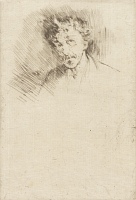Etchings Institutions search term: colby
Whistler with the White Lock | ||
| Number: | 162 | |
| Date: | 1876/1879 | |
| Medium: | etching and drypoint | |
| Size: | 118 x 80 mm | |
| Signed: | no | |
| Inscribed: | no | |
| Set/Publication: | 'Cancelled Plates', 1879 | |
| No. of States: | 1 | |
| Known impressions: | 34 | |
| Catalogues: | K.172; M.169; W.142 | |
| Impressions taken from this plate (34) | ||
TECHNIQUE

One impression, reproduced above - possibly the first impression because it still prints with burr - was very thoroughly worked over in pen and wash to suggest how the finished drypoint might work ( ). This was very skilfully done, probably by Whistler himself. It is signed with a butterfly that appears to date from 1878 or 1879 but is not certainly by Whistler - it is a bit too tidy.
). This was very skilfully done, probably by Whistler himself. It is signed with a butterfly that appears to date from 1878 or 1879 but is not certainly by Whistler - it is a bit too tidy.
 ). This was very skilfully done, probably by Whistler himself. It is signed with a butterfly that appears to date from 1878 or 1879 but is not certainly by Whistler - it is a bit too tidy.
). This was very skilfully done, probably by Whistler himself. It is signed with a butterfly that appears to date from 1878 or 1879 but is not certainly by Whistler - it is a bit too tidy.PRINTING
Half of all known impressions are in the set of 'Cancelled Plates' although this particular drypoint does not appear to have been actually cancelled, but just left unfinished.
A few impressions can be traced back to Whistler's time. All are printed in black ink. One prints with a rich burr and was worked over in wash, as mentioned above; it is on ivory laid paper with an Arms of Amsterdam watermark ( ). Two are on wove paper, the first an early impression preceding the main edition of the album of Cancelled Plates ('Cancelled Set') by The Fine Art Society, in 1879 (
). Two are on wove paper, the first an early impression preceding the main edition of the album of Cancelled Plates ('Cancelled Set') by The Fine Art Society, in 1879 ( ) and the other also perhaps printed at that time (
) and the other also perhaps printed at that time ( ).
).
 ). Two are on wove paper, the first an early impression preceding the main edition of the album of Cancelled Plates ('Cancelled Set') by The Fine Art Society, in 1879 (
). Two are on wove paper, the first an early impression preceding the main edition of the album of Cancelled Plates ('Cancelled Set') by The Fine Art Society, in 1879 ( ) and the other also perhaps printed at that time (
) and the other also perhaps printed at that time ( ).
).Some of the etchings and drypoints in the surviving sets of the Cancelled Plates are still bound in an album (i.e.  ). They are printed in black ink usually on ivory laid paper, sometimes with a watermark, such as the partial watermark, Strasbourg Lily 'VGZ' (i.e.
). They are printed in black ink usually on ivory laid paper, sometimes with a watermark, such as the partial watermark, Strasbourg Lily 'VGZ' (i.e.  ) or 'Van Gelder' in script (
) or 'Van Gelder' in script ( ). There was an edition of at least 20 and perhaps about 24 at that time.
). There was an edition of at least 20 and perhaps about 24 at that time.
 ). They are printed in black ink usually on ivory laid paper, sometimes with a watermark, such as the partial watermark, Strasbourg Lily 'VGZ' (i.e.
). They are printed in black ink usually on ivory laid paper, sometimes with a watermark, such as the partial watermark, Strasbourg Lily 'VGZ' (i.e.  ) or 'Van Gelder' in script (
) or 'Van Gelder' in script ( ). There was an edition of at least 20 and perhaps about 24 at that time.
). There was an edition of at least 20 and perhaps about 24 at that time.Ten years later, in 1889, the copper plate was acquired by H. Wunderlich & Co., New York and printed again in an edition of sixteen, of which seven have been identified. It was printed very carefully and impressions appear stronger than earlier impressions, partly because some of them are on coloured papers.
Finally, an impression printed in black ink on grey laid paper with a Pro Patria countermark ( ) was sold by H. Wunderlich & Co. together with one from the fully cancelled plate, printed on pale green paper with the Arms of Colbert watermark, probably in the 1930s. They were given by Lessing Julius Rosenwald (1891-1971) to the National Gallery of Art, Washington, D.C. (
) was sold by H. Wunderlich & Co. together with one from the fully cancelled plate, printed on pale green paper with the Arms of Colbert watermark, probably in the 1930s. They were given by Lessing Julius Rosenwald (1891-1971) to the National Gallery of Art, Washington, D.C. ( ).
).
 ) was sold by H. Wunderlich & Co. together with one from the fully cancelled plate, printed on pale green paper with the Arms of Colbert watermark, probably in the 1930s. They were given by Lessing Julius Rosenwald (1891-1971) to the National Gallery of Art, Washington, D.C. (
) was sold by H. Wunderlich & Co. together with one from the fully cancelled plate, printed on pale green paper with the Arms of Colbert watermark, probably in the 1930s. They were given by Lessing Julius Rosenwald (1891-1971) to the National Gallery of Art, Washington, D.C. ( ).
).
